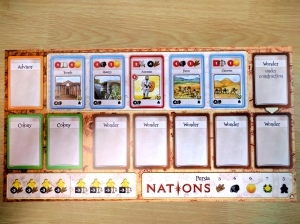Most civilization-building games are bittersweet. On the one hand, they provide players with rich, fulfilling and productive experience, while allowing for deep, strategic choices to be made. On the other hand, a lot of them are way too long and complex, making your friends’ eyes glaze over with feigned interest while you attempt to explain the rules with increasingly sweaty palms. There have also been some quicker and simpler games available, but their lack of depth inadvertently brands them as nothing more than fillers between longer game sessions. Among all the civilization building games, there has been none as deep and fulfilling as Through the Ages: A Story of Civilization. However that game is also at least 4 hours long, and that is for experienced players. It is also unforgivably hard, fiddly and somewhat abstract.
The closest, more accessible alternative I have found so far is Nations. As a bonus, the designers’ names come with circles on the As.
- Designer: Rustan Håkansson, Nina Håkansson, Einar Rosén, Robert Rosén
- Publisher: Lautapelit.fi
- Year published: 2013
- Number of Players: 1-5; Best with 3
- Playing time: 40 minutes per player.
Overview
Nations covers 4 Ages, from Antiquity (476-1453) to Industrial (1760-1850) with each Age spanning 2 game rounds. Each round is divided into 3 phases: Maintenance, Action and Resolution. I will explain each phase in greater detail later in the review. There are ways to adjust the difficulty levels of the game to make it easier for beginners or more challenging for experienced players.
Components
For a modern board game, the artwork is comparable to older classical board games; it is aesthetically simple but functional.

The icons depicting the various resources are easy to remember and instinctive. A few rounds and they will be second nature. For less experienced players and turkeys, the game comes with handy dandy player aids.

Gold is used for buying Progress cards; Stone for deploying workers in Buildings, recruiting Military, and building Wonders; Food allows for population growth and protects from famine; Books provides VPs at the end of every Age.
Cards are of good quality; mounted boards are thick and sturdy, while player boards are made of thick card stock. Overall, the components are top-notch and worth the price. However, there are a lot of them: Hundreds of cards and tokens, boards for each player and the main boards. Definitely get a big table or a play on the floor. Yes, I have friends who play board games on the floor. Suffice to say we no longer play at their places.
Gameplay
If you organize your components, setup and cleanup are fairly quick. After setting up the Scoring and Progress boards, each player needs to pick a nation to play as. Take the board you like then choose a side to play with: A- or B-side. A-side is for your first game and all players would have identical starting setup. Pick B-side if you prefer each player to begin with unique starting setups. Here is a comparison of the A- and B-sides of the Persia board.


Now let us take a look at a summary of a round. We start with…
This phase is the upkeep phase so there aren’t many decisions to be made. Taking note of the new Event card and Progress cards really helps you decide your next move in which you pick one of the three actions available in the…


This is the chunk of the decision you have to make in the game. The Progress cards provide you with effects and powers to help you build your nation and form your strategy. As the game progresses, you obtain more Progress cards which you place on your Player board.
Place a Worker on either your Military cards (to grow your army), or your Building cards (to make them work in them).
After all players pass, we see how the round resolves in the…
The game ends after Round 8, and players score VPs based on the cards on their Player boards, resources and VP tokens they have accumulated during the game. The nation with the most VPs is the winner. Huzzah!
Final Thoughts
Although I would not herald Nations as the best Civilization game ever, it does what it sets out to do: create a simple, accessible engine-building experience that is different every time you play it. Here are the reasons why I think Nations deserve a spot in anyone’s collection:
- The decision making process is so intuitive and thematic, yet straightforward enough any casual gamer would have no trouble lapping it up.
- It rewards you for maintaining a balanced and unique strategy.
- It does not punish you for choosing peaceful tactics over more aggressive strategy, and does in fact provide you with tools to deal with warlike players.
- It is a gamer’s game that I would not hesitate to bring to a gaming session because the possibility of getting it on to the table is quite high due to its customizable length.
- It is awfully balanced almost to a fault.
And there we have it. Thanks for reading this far. I am off to celebrate my first board game review blog with a glass of ginger ale and a good night sleep, in that order. Check back for more in a couple of weeks.
